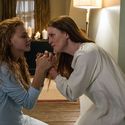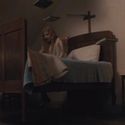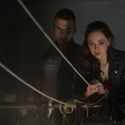Movie Review - CARRIE
November 14, 2013
Most of us are familiar with the story of CARRIE; be it through Stephen King’s novel or the classic 1976 Brian de Palma film starring Sissy Spacek, complete with the now iconic blood-drenched imagery etched into our collective consciousness. Such a classic, it begs the question: Why? Why a new version? Why a remake? Why a reimagination? The answer is because this new 2013 CARRIE from director Kimberly Peirce is just that - a reimagination that harkens back to the original source material - King’s novel.
As noted by Julianne Moore, who plays CARRIE’s mother Margaret, “I think it’s important to note how strong the source material is. That novel is really an extraordinary novel. If you read Stephen King’s book on writing, he talks about how that was his first published novel and he had thrown it in the trash. His wife pulled it out of the trash. . .He was working as a janitor at the time and he noticed a tampon dispenser in the girls’ locker room and asked his wife what it was. And she told him what it was. Then he remembered these two girls that he’d grown up with. Both of them were extremely marginalized; one by her extremely religious parents and the other one by poverty. . .They both dies in their 20's for various reasons. He just thought about them and thought about how hard it must have been for them. . .and it all ended up being the basis for this story. For me, that’s the heart of CARRIE. That’s the genius of Stephen King. He manages to take a social issue, social cultural issue that doesn’t die, doesn’t go away and turn it into a grand horrific story about adolescence.”
For Peirce, at the heart of this 2013 reimagination is the deepening of understanding and backstory of Margaret which then gives us a point of reference for the volatile mother-daughter dynamic as well as an empathy and sympathy for CARRIE. But, going beyond that, Peirce herself digs deep into King’s source material, shining a light on the super-hero aspect of Carrie White herself and her telekinetic power, thus elevating, layering and texturing the emotional levels of the story. The result is both inspired and inspiring
For the uninitiated, Carrie White is a shy high school girl who has been raised by a deeply devout far-right Fundamentalist mother. Home-schooled until high school, Carrie has been shielded and sheltered from the world. No tv, no street smarts, no real interaction with people let alone peers. When “bad”, her mother locks her in a closet plastered with crucifixes of Christ in various states of torment or repose, demanding prayer and repentance. The result is that CARRIE’s awkwardness and insecurity makes her the victim of horrific bullying when she enters public school. Her gym teacher Miss Desjardin takes a very maternal and protective interest in CARRIE, going to great lengths to punish CARRIE’s tormentors, in particular, leader of the hateful pack, Chris. Unfortunately, Miss Desjardin’s efforts come at a price - Chris wanting vengeance against CARRIE. Seeing the horror in Chris’ misconduct and attitude does have a positive effect though as Chris’ one-time best friend Sue and her boyfriend Tommy try to make amends for the torment Chris has repeatedly unleashed on CARRIE. So ashamed by her own part in some of Chris’ schemes, Sue even foregoes the prom and has Tommy ask CARRIE.
And while CARRIE gets caught up in the wonder of “the prom” after all the terrible things that have happened to her, she also experiences something else wonderful. As she comes into her own, she finds that she has telekinetic powers. Diverting herself from the pain of bullying and her mother’s cloistered psychosis, she focuses on the wonder of learning about her gift, and celebrating the joy of being asked to the prom. We begin to see a light in CARRIE’s spirit, a light that her mother - and Chris - threaten to extinguish, forcing CARRIE to exercise the limits of her newfound power on prom night turning a dream into a nightmare from hell.
Chloe Grace Moretz is a refreshing delight as CARRIE. Making the transition into this more mature role, and thanks to a strongly constructed character and thematic elements more in line with King’s book, Moretz gives CARRIE herself a depth and dimension that was absent in Sissy Spacek’s 1976 performance. Moretz is as believable as a shy, frightened teenager as she is a telekinesis wielding monster (with some really cool zombielike/demonic stilted movements to her physicality) or smiling beautiful prom queen, much of which is due to her level of acting experience and ability to immerse herself in character and story. Her scenes with Julianne Moore are powerful, riveting us to the screen, particularly in the climactic third act. As Moore lovingly notes, “It was fun for me to work with a true adolescent. . .She is so delightful. We got very close on the set. . . It was really important to me that she feel comfortable with me, that she turned to me if she needed anything. . . It makes you able to go as far as you can emotionally, especially when you’re dealing with a child.” Of particular note is that Moretz captures the hope and positive energy of this reimagination of the character of CARRIE, from the sweetest nuance of a slowly awakening smile to widening smiling eyes. During displays of her exploring CARRIE’s newfound telekinetic, a symbiosis between performance and script displays an almost “super hero vibe” that is welcoming, creating a wonderful emotional dichotomy and ambiguity. We see Moretz grow and change and come into her own right before our eyes just like CARRIE.
As Margaret, Julianne Moore is nuanced texture and depth of emotion. She makes you want to explore Margaret’s psyche and understand what makes her tick. Much expanded here from the 1976 film, the role allows for Moore to dig deeper, get back to King’s themes and construct, delivering a performance that is psychological mind-blowing. Thanks to director Peirce and screenwriter Roberto Aguirre-Sacasa, we see Margaret’s psychosis play out on screen, starting with the birth of CARRIE and leading us through Margaret’s loneliness and her own brand of penitence - self-flagellation. Be it by banging her head against a wall or self-mutilation with knives, seam rippers, scissors, etc., we see the cavernous cracks within her, something that allows Moore to dig in and play.
“ The very first scene where she gives birth. That was important to me in developing the character because this woman was so isolated, so crazy, that she didn’t know she was pregnant. She and her husband were involved in a religious organization. She found the organization too lax, so they separated from that organization and formed their own church. They were their own church. He died, leaving her alone and presumably pregnant. She thought she had cancer. She thought she was dying and then gave birth to this baby girl. When you think this is how isolated she was and yet this was her only relationship, this little girl. Starting there with kind of basis of her character. It was a wonderful thing to have from the book; that idea. That’s where she was coming from and that’s the kind of world Carrie was growing up in. . . . I loved all of the self-mutilation stuff!” Stepping back and looking at the abusive nature of Margaret, Moore notes that the self-flagellation and the “cutting” tells us that Margaret “is trying to feel something, is so far away from themselves and any kind of reality” that it makes her “insanely abusive.”
Supporting cast is strong, starting with Portia Doubleday who, as Carrie’s lead tormentor, Chris, delivers a performance steeped in emotion, capturing the nuance and fracture that makes Chris who she is. Doubleday’s emotional and peer-driven fall from grace is impactful and she nails the character fully from vocal intonation and inflection to facial expression. As the penitent Sue Snell, Gabriella Wilde also embodies her character arc with a grounded believability and sensitivity. Judy Greer easily tackles the role of Miss Desjardin with a non-nonsense, yet compassionate tone.
Directed by Kimberly Peirce and written by Roberto Aguirre-Sacasa based on Lawrence D. Cohen’s original screenplay and the novel by Stephen King, CARRIE soars on its own wings and as noted, tackles social issues, and particularly bullying, with a 21st century spin. As Moore, a mother herself, notes, “[Bullying] is a huge, huge topic. You need to be very very careful with it. You can’t tar everything with the same brush because there’s a tremendous spectrum of behavior. At one end you might have teasing. . . but then there’s true isolation and real abuse.” Also coming into play are concerns about the religious themes in the film. According to Peirce, “That was one of the most fascinating things for both Julianne [Moore] and I. . .How do you make that clear, that [Margaret] was part of a church and she left? [We had to] make sure the iconography in the house was specific, but didn’t make you go down the road of one religion. . .we felt a big responsibility to get it right.” Together with production designer Carol Spier, that concern, and others, are succinctly achieved.
Described by Peirce as a “horror thriller [with] a girl who has super powers and as she goes through those super powers, it’s thrilling and it’s terrifying to see how they’re gonna manifest”, Aguirre-Sacasa and Peirce walk the fine line of story, paying homage to De Palma’s film, while making CARRIE their own. While the “biggest engine of the story is the mother-daughter relationship. . .the second thing is the powers. The powers drive her forward because it’s an identity story, it’s a girl who’s getting control of something. . .and if I was going to honor the book, that I would bring up the super hero origin story.”
As strong as the story is, the visuals are equally so. A director who “likes building real worlds”, Peirce turned to cinematographer Steve Yedlin and visual effects guru Dennis Berardi for the expertise that allowed her to “live in a digital domain and actually do things that hadn’t been before but integrate them fully on a story and character level.”
“I wanted a story that you fell in love with and you went deeply inside the main characters. It was important to me that the choice of colors would be intoxicating to you, that it would bring you in. It was also important because I was moving from film to digital. I used the Alexa and the Alexa has a level of warmth and depth to it that will also bring you in. I spent a lot of time with Steve on the equivalent of a mini-techno crane. . .I kept that techno-crane alive on my set everyday and it allowed us to just move into places that you couldn’t imagine. That allowed us to feel connected to the characters. . .The Steadi-Cam was also important to me. In the house, I wanted you to feel when Margaret was chasing Carrie down because Margaret was dominating her (and vice versa), that that Steadi-Cam was right on her and as she’s going, you’re moving back and you feel the walls of that house close in on you.” When it comes to visual effects, something “really important” to Peirce, “Again, going back to the powers and back to this protagonist who we love, they were always emanating out of her. That was something with Dennis that we really worked on.”
Filmmakers will appreciate the fact that Peirce and her team did more than a few things “out of the norm”; one of them being the climactic destruction of the White residence which was done early on in the production as opposed to the end. For Peirce, “That was thrilling to be able to do that to the house!” Designed so as to “collapse” and fold in on itself, while the White house itself was a physical structure with real sets and design, the destruction was executed digitally. Photo-surveying the house with over 6500 images and a lidar scan, the digital house was created which then allowed for dazzling visual destruction, complete with stones and boulders falling from the sky. On the other hand, when it came to the infamous prom sequence, much of the scene was approached as an action movie, melding practical physical stunts and effects with camera tricks and digital enhancements. Wire rigging also plays heavy in the practical stunt executions throughout the film, with Moretz and Moore doing all of their own stunt work.
Integrated with the story, lighting and color saturation is clear, crisp, saturated and distinctive, establishing a tonal bandwidth that visually mirrors the story and its emotional palette. And when it comes to blood? As Moretz herself chuckles, “We had a Book-O-Blood.”
The time is right. The time is now. As terrifying as ever, as hopeful and empowering as King’s original words, in all of its blood-soaked glory, CARRIE comes of age for a new generation.
Directed by Kimberly Peirce
Screenplay by Roberto Aguirre-Sacasa and Lawrence D. Cohen
based on the novel by Stephen King
Cast: Chloe Grace Moretz, Julianne Moore, Judy Greer, Portia Doubleday,
Ansel Elgart, Gabriella Wilde
genre: horror



























Reader Comments(0)